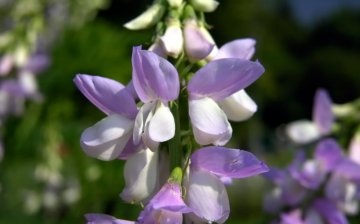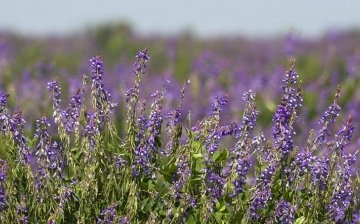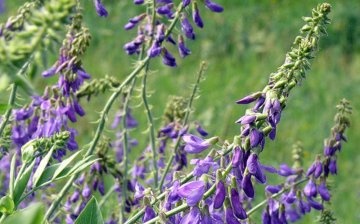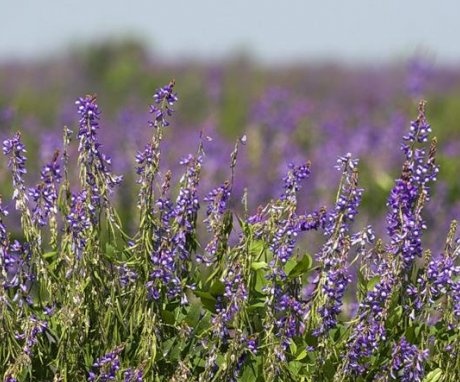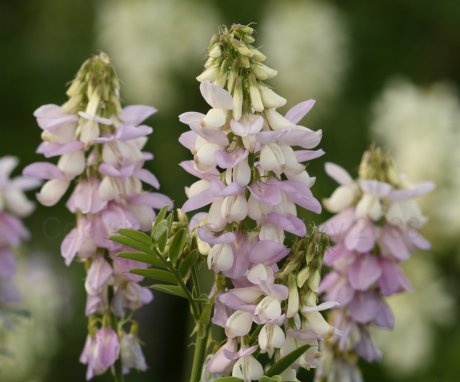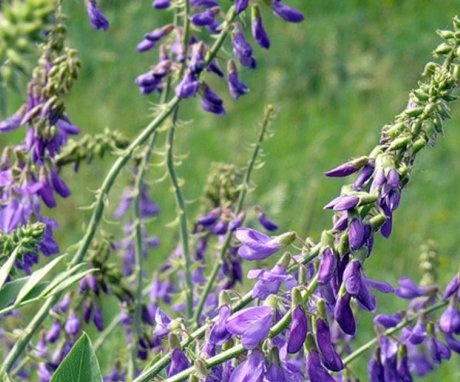Goat's rue herb - features of cultivation and useful properties
The goat's rue herb, which is not recognized by traditional medicine, finds its use among traditional healers. It is a medicinal species of goat's rue, but there is also an oriental variety of this plant, which has a value as a forage crop. The goat's rue is also known under other names: forest solodian, galega, goat rue.
Content:
Description of the plant
Goat's rue - perennial herbaceous plant of the legume family. An erect, branched stem usually reaches a height of one meter, on fertile soil it can grow up to one and a half meters. Root system rod type, grows to a depth of 80 centimeters. Several offspring are formed on the main root, which first develop horizontally up to 30 centimeters, and then break through to the soil surface and form new stems. This property of the plant contributes to the thickening of the plantings over the years.
On the underground part of the plant during the growing season, 3-4 wintering buds are formed, which wake up in the spring and give rise to new shoots.
Unpaired petiolate leaves grow up to 30 centimeters long.
Flowers of pale purple or blue flowers, similar to bells, collected in inflorescences-brushes.
3-5 inflorescences are formed on one stem. The fruiting period is from September to October. The beans are small - from 2 to 4 centimeters long, dark orange, almost brown in color, the number of seeds in the fruits - from three to seven pieces. Seeds retain germination qualities for 8 years. The plant is characterized by slow growth, and if by autumn it does not reach at least 20 centimeters in height, it is recommended to postpone its harvesting to the next year.
Goat's rue is a frost-resistant plant that tolerates even the most severe winters. Possessing the quality of honey plant, it is an excellent way to attract bees to the site, which serve as natural pollinators for other crops. Currently, two types of grass goat's rue are known: oriental, which is grown as a fodder crop, and medicinal. In the wild, it grows mainly in the Caucasus, Ukraine, Moldova and the European part of Russia.
Beneficial features
Goat's rue herb contains many beneficial substances:
- Tannins
- Penagin
- Alkaloids
- Carbohydrates
- Pipecolic acid
- Rutin
- Flavonoids
- Kaempferol
- Vitamin C
- Carotene
- Quercetin
The seeds of the plant contain nitrogen-containing compounds, sucrose, fatty oil and organic acids. The goat's rue is widely used in folk medicine, as it has many properties:
- Diuretic
- Lactogenic
- Diaphoretic
- Anthelminthic
- Antibacterial
Fresh goat's rue juice can be used to treat fresh or festering wounds, it has an excellent anti-inflammatory and healing effect. Due to its powerful lactogenic effect, decoctions of the plant are recommended for nursing mothers with insufficient production of breast milk. Goat's rue contains galegin, an alkaloid that helps lower blood sugar levels. For milder forms of diabetes, it can be used as a medicine.In moderate to severe forms of this disease, preparations from the plant are used as a supplement to insulin.
With the use of goat's rue and preparations from it, blood pressure may increase, and disturbances in the functioning of the intestines are possible. Therefore, the drug should be used with caution, strictly observing the dosage. Pregnant women are strictly prohibited from using goat's rue and preparations from it. It is best to take this treatment under the supervision of a doctor.
For the preparation of medicines from the goat's rue, only the aerial part of the plant is used: leaves, stems, flowers and seeds.
Goat's rue is an excellent melliferous plant, and due to its medicinal properties, the honey of this plant has a special value, which traditional healers try to collect during flowering.
Growing conditions
The goat's rue can grow in a wide variety of places: in meadows, in the steppes, in thickets of bushes, along the banks of water bodies. In general, the plant prefers swampy areas, lowland areas. It is quite unpretentious, frost-resistant and grows on any type of soil, except for acidic and sandy, and does not tolerate close occurrence (more than 1.3 - 1.5 m) of groundwater.
Best of all for cultivation cultivated sod-calcareous, sod-podzolic, medium and light loamy, as well as peat soils are suitable. It is better to choose areas that are flat so that water does not accumulate on them.
To avoid migration pests goat's rue crops should be kept away from other legumes.
When growing a goat's rue, it is important to observe 2 basic conditions:
- Firstly, this is a large amount of light, otherwise the harvest will be very scarce.
- Secondly, keeping the soil moist, but not waterlogged, condition.
Goat's rue is an excellent green manure, which also has antibacterial properties. The plant improves the quality of the soil by enriching and cleaning it. As a legume, goat's rue helps to accumulate biologically pure nitrogen in the soil. The goat's rue grass is suitable for growing in all agricultural regions of Russia, in one place it can grow up to 15 years (there is a known case of growing a plant in one place for 27 years) and gives up to 2-3 harvests of green mass per season.
Reproduction and care
The goat's rue can be propagated vegetatively (dividing a bush) and seeds... Reproduction by dividing the bush is carried out in the fall, once every 3-5 years. Separate stems with rosettes and roots are separated from a large bush and planted in the soil.
The best time to plant is early spring.
When sowing, the seeds are deepened into the soil by 1.5 centimeters and rolled. Since the seeds have a dense shell, it is recommended to carry out a scarification procedure before sowing, for example, sand them with sandpaper. Scarified seeds sprout in 10-12 days. The goat's rue is planted in rows with an interval of 45 centimeters, if the purpose of growing is to obtain seed, the distance between the rows must be left 70 centimeters.
In order for the nodules to develop well on the roots, you need to process the seeds in a special way:
- Dig out roots with nodules from an adult (perennial) goat's rue.
- Crush in a mortar.
- Add water.
- Moisten the seeds with the resulting mixture.
- Sow in moist soil the same day.
- Or treat the seeds with Rizotorfin.
If you do not carry out such treatment, you can feed the seedlings with any nitrogen fertilizereg urea. In the first month after the emergence of seedlings, the root system is actively developing, and the aboveground part, on the contrary, grows very slowly. Therefore, during this period, it is important to clean weedsso that they do not clog the crops. In the second and subsequent years, the goat's rue, expanding, itself suppresses the weeds.
By the end of the season, in the first year after planting, the goat's rue rarely reaches a height of at least half a meter. In autumn, plants are cut to a height of 20 centimeters. The goat's rue reaches its maximum growth in the second and subsequent years.Therefore, it is not recommended to harvest the crop in the first year.
Goat's rue is a cross-pollinated plant, therefore, it is not recommended to plant oriental and medicinal species nearby.
In the first year of growth, caring for a herbaceous plant consists in loosening the inter-row space and regularly watering. Top dressing carried out at the beginning of spring and after each harvest of green mass (for forage varieties):
- Phosphate-potassium fertilizer (1 tablespoon per bucket of water)
- Fermented mullein (1:10 solution) or bird droppings (1:20 solution).
- As a fertilizer, you can use wood ash, the goat's rue responds very gratefully to such nutrition.
- To increase the yield at the beginning of flowering, foliar dressing is carried out with micronutrient fertilizers or sodium humate.
To avoid depletion of the soil under the goat's rue, it is recommended to leave the area with the plant for seed ripening every 3 years. Harvesting of goat's rue grass is carried out from June to August, during the flowering period, seeds - after they ripen in the fall. Both seeds and grass are dried outdoors.
More information can be found in the video.



